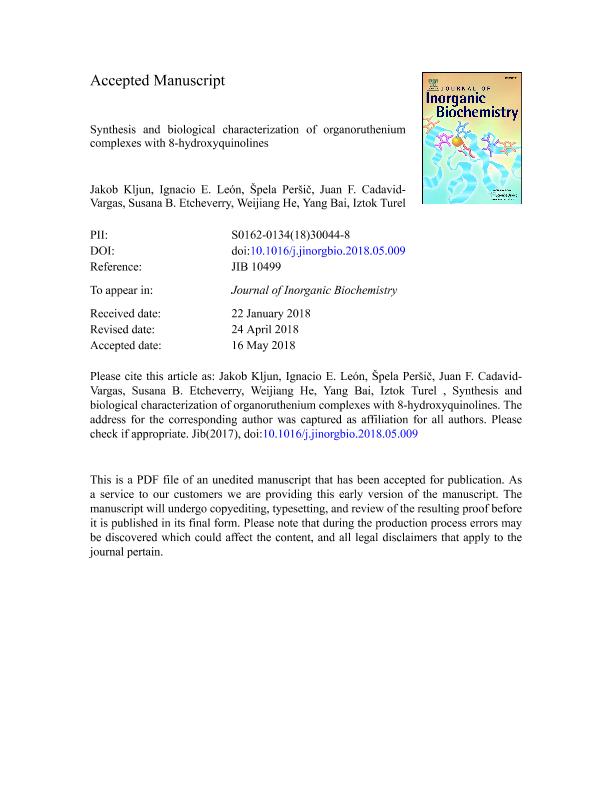Artículo
Synthesis and biological characterization of organoruthenium complexes with 8-hydroxyquinolines
Kljun, Jakob; Leon, Ignacio Esteban ; Pervi, Spela; Cadavid Vargas, Juan Fernando
; Pervi, Spela; Cadavid Vargas, Juan Fernando ; Etcheverry, Susana Beatriz
; Etcheverry, Susana Beatriz ; He, Weijiang; Bai, Yang; Turel, Iztok
; He, Weijiang; Bai, Yang; Turel, Iztok
 ; Pervi, Spela; Cadavid Vargas, Juan Fernando
; Pervi, Spela; Cadavid Vargas, Juan Fernando ; Etcheverry, Susana Beatriz
; Etcheverry, Susana Beatriz ; He, Weijiang; Bai, Yang; Turel, Iztok
; He, Weijiang; Bai, Yang; Turel, Iztok
Fecha de publicación:
09/2018
Editorial:
Elsevier Science Inc
Revista:
Journal of Inorganic Biochemistry
ISSN:
0162-0134
Idioma:
Inglés
Tipo de recurso:
Artículo publicado
Clasificación temática:
Resumen
In this study we report the synthesis, characterization and a thorough biological evaluation of twelve organoruthenium?8-hydroxyquinolinato (Ru-hq) complexes. The chosen hqH ligands bear various halogen atoms in different positions which enables to study effect of the substituents on physico-chemical and biological properties. The determined crystal structures of novel complexes expectedly show the cymene ring, a bidentately coordinated deprotonated hq and a halide ligand (chlorido or iodido) coordinated to the ruthenium central ion. In previous studies the anticancer potential of organoruthenium complex with 8-hydroxyquinoline ligand clioquinol was well established and we have decided to perform an extended biological evaluation (antibacterial and antitumor activity) of the whole series of halo-substituted analogs. Beside the cytotoxic potential of studied compounds also the effect of two selected complexes (9 and 10) on apoptosis induction in MG-63 and A549 cells was also studied via externalization of phosphatidylserine at the outer plasma membrane leaflet. Both selected complexes that gave best preliminary cytotoxicity results contain bromo substituted hq ligands. Apoptosis induction results are in agreement with the cell viability assays suggesting the higher and more selective anticancer activity of complex 10 in comparison to complex 9 on MG-63 cells.
Palabras clave:
QUINOLINES
,
RUTHENIUM
,
CANCER
,
COMPLEXES
Archivos asociados
Licencia
Identificadores
Colecciones
Articulos(CEQUINOR)
Articulos de CENTRO DE QUIMICA INORGANICA "DR. PEDRO J. AYMONINO"
Articulos de CENTRO DE QUIMICA INORGANICA "DR. PEDRO J. AYMONINO"
Citación
Kljun, Jakob; Leon, Ignacio Esteban; Pervi, Spela; Cadavid Vargas, Juan Fernando; Etcheverry, Susana Beatriz; et al.; Synthesis and biological characterization of organoruthenium complexes with 8-hydroxyquinolines; Elsevier Science Inc; Journal of Inorganic Biochemistry; 186; 9-2018; 187-196
Compartir
Altmétricas



